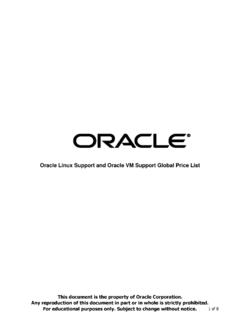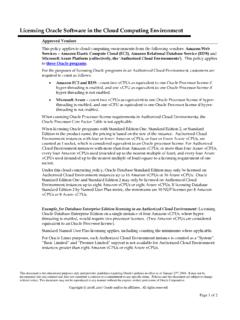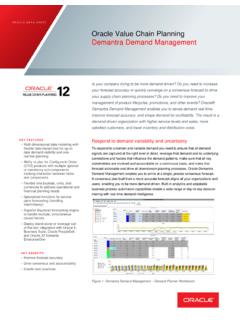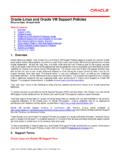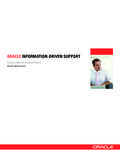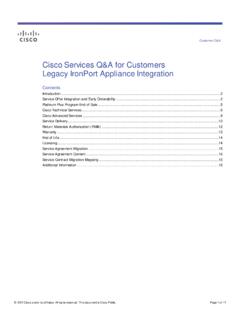Transcription of Why Oracle Database Runs best on Oracle Linux
1 Why Oracle Database Runs Best on Oracle Linux WHITE PAPER / JULY 27, 2018. Table of Contents Introduction .. 3. Oracle Database is Developed on Oracle Linux .. 4. Oracle Linux Advantages for Database Deployments .. 4. Mission-Critical Reliability, Availability, and Serviceability (RAS) .. 6. Simplified Virtualized 8. Cloud-Ready Integrated Services .. 8. Full-Stack 9. Rapid Deployments .. 9. Conclusion .. 11. For More Information .. 12. 2 W HITE PAPER / Why Oracle Database Runs Best on Oracle Linux INTRODUCTION. Many essential business applications such as order entry, financials, human resources, customer relationship management, and enterprise resource planning run on an Oracle Database . These applications sustain core operations that generate revenue, improve business efficiency, and increase profitability. Because business success often depends closely on these strategic applications, IT departments strive to provide an optimal Oracle Database infrastructure one that delivers responsive performance, scalable capacity, tight security, and always-on availability.
2 The infrastructure must also be easy to manage and support fast Database server provisioning, allowing transaction capacity to be added easily and deployed into production quickly. For Oracle Database workloads running on Oracle Linux , on premises or in the cloud, deep testing and integration between the layers brings substantial benefits: fast transaction speeds, scalable performance, and the security and reliability needed to meet strict service level agreements (SLAs). In addition, an end-to-end Oracle stack increases administrative efficiency since there's no need for cross-platform skill sets to manage multiple vendor technologies. And there's the added benefit of a single point of contact from the industry's leading Database infrastructure experts, and for your most critical service and support issues. Oracle Database is built on a multi-tenant architecture designed to simplify the process of evolving to a cloud-based Database -as-a-Service (DBaaS).
3 Delivery model. To build an optimal infrastructure for Oracle Database 18c or other releases, forward-thinking solution architects select Oracle Linux for the operating system tier. Oracle Linux is a cloud-ready operating system that is a cost-effective and high-performance choice when modernizing infrastructure or consolidating Database instances on Oracle Database . This paper explains why Oracle Linux is your best choice for Oracle Database environments. 3 W HITE PAPER / Why Oracle Database Runs Best on Oracle Linux Oracle Database IS DEVELOPED ON Oracle Linux . Many customers choose Oracle Linux to support their mission-critical applications. Oracle Linux is also the principal operating system for Oracle 's own Database , middleware, and application software engineering projects. Oracle Cloud Applications, Oracle Cloud Platform, and Oracle Cloud Infrastructure run on Oracle Linux . Oracle Linux is the development standard across the Oracle Database product portfolio with more than 175,000 Oracle Linux instances deployed on both physical and virtual servers.
4 Oracle Linux receives more than 128,000 hours of Database and application testing each day, which hardens software releases throughout each product's lifecycle. Even before formal evaluation occurs, Oracle Linux is the base platform on which developers prove functionality, quality, and software viability. And before any Database or application software is made available, Oracle engineering teams conduct formal stress tests on Oracle Linux to certify Oracle Database and Oracle Real Application Clusters (RAC), along with an extensive battery of system verification and performance tests. Oracle Linux includes the Unbreakable Enterprise Kernel (UEK), which is specifically optimized for the best performance of Oracle software. The Oracle Database and Oracle Linux development teams collaborate on UEK performance enhancements, tuning system calls and C library interfaces that accelerate applications and query processing times. Oracle engineers extensively test the optimized UEK across Oracle 's Database , middleware, and application tiers as well as on Oracle servers and engineered systems.
5 UEK is also subject to incremental and widespread testing across IT. development systems running the family of Oracle Database products. The Industry Standard for Oracle Database Oracle Linux is used extensively by thousands of Oracle Cloud customers worldwide. Thousands of Independent Software Vendors (ISVs) certify their software on Oracle Linux . In addition to the thousands of servers that support Oracle 's internal development teams, Oracle Linux is experiencing rapid adoption in the commercial Linux marketplace, gaining broad acceptance as the enterprise standard for Oracle Database workloads. According to the industry analyst firm IDC, Oracle Linux has been realizing significant market growth: Oracle Linux has been consistently one of the fastest growing enterprise Linux distributions in the past few years. Much of this growth comes from customers moving to Oracle Linux in order to take advantage of Oracle on Oracle ' , Oracle 's OS optimization for its own solution stacks, running on-premises and in the cloud - Ashish Nadkarni, IDC.
6 This success highlights how IT organizations are increasingly selecting Oracle Linux on x86 systems to create mission-critical Database infrastructures that are responsive, highly scalable, and cost- effective. Oracle Linux ADVANTAGES FOR Database DEPLOYMENTS. Beyond the flexibility and low TCO of open source, Oracle Linux offers enterprise-class performance, security, and mission-critical reliability, availability, and serviceability (RAS). But what distinguishes Oracle Linux from other OS platforms in particular for Oracle Database workloads are advantages afforded by the operating system's deep integration with the solution stack, optimizations resulting from industry collaborations, and UEK enhancements. Optimized Transaction Performance and Scale Oracle Database and Oracle Linux engineering teams collaborate continuously on improvements and optimizations to boost Database application performance. For example, when traditional inter-process communication (IPC) mechanisms exhibited stability issues under heavy loads, Oracle engineers pioneered a new approach Reliable Datagram Sockets (RDS), a low-latency connectionless 4 W HITE PAPER / Why Oracle Database Runs Best on Oracle Linux protocol for delivering datagrams reliably to thousands of endpoints.
7 Because RDS resulted in fewer retransmissions (especially during times of peak processing), it greatly improved Database performance on Linux . Oracle contributed the RDS code to the open source community and it is now part of the Linux kernel. As a result, Oracle Database engineers were subsequently able to simplify the Database code, removing extraneous user code that addressed the instability issues allowing Oracle Linux to do the heavy lifting for high-performance Database communications. Other optimizations stem from enhancements designed to accelerate performance on today's multicore x86 processors and advanced systems architectures. Historically Linux was widely deployed for compute- and data-intensive High-Performance Computing (HPC) applications. InfiniBand, which offers superior throughput, low latency, and excellent scalability, was frequently used as a switching fabric in demanding HPC applications and is now a prevalent technology throughout enterprise data centers for similar reasons.
8 Notably, InfiniBand switches are a critical component in the Oracle Exadata Database Machine (an Oracle engineered system targeted at extreme Database performance) in which InfiniBand provides high-bandwidth connections between the system's compute and storage nodes. Data throughput performance in Oracle Exadata depends heavily on the optimized InfiniBand networking stack in Oracle Linux , the core OS in these powerful systems. Oracle developers tuned the Oracle Linux Infiniband stack to scale throughput in support of extremely demanding workloads. Oracle ultimately contributed these performance-related improvements for InfiniBand to the open source community . one of many technologies that the Oracle Linux team has made to further the success of open source. Collaborating with Intel has also resulted in enhancements that help Oracle Database applications scale well on x86 servers running Oracle Linux . Working with Oracle Database engineers, Intel optimized CPU threading algorithms, allowing the Database to take advantage of Intel SIMD and AVX.
9 Instructions that improve NUMA scalability. In addition, Oracle Database software uses the multi- threaded Intel IPP (Intel Integrated Performance Primitives) library to accelerate columnar compression/decompression as well as encryption operations. For Database applications compiled on Oracle Linux , Oracle and Intel also recommend the optimized Intel compiler to obtain the best possible application performance. Oracle Linux with UEK includes extensive performance and scalability improvements to the process scheduler, memory management, file systems, and the networking stack. It was tuned to perform better and faster on leading-edge x86 configurations that feature many CPU cores and large amounts of main memory. Optimized libraries and system calls help to improve performance for Oracle Database queries. Because of these optimizations and pervasive testing that occurs within Oracle , Oracle Linux is able to address large transaction capacities and scale well as the number of Database users or the number of databases increases.
10 For companies consolidating multiple databases on the Oracle Database , fast transaction response times and good scalability are key factors that contribute to a cost-effective infrastructure. Improvements to the operating system are also pushed upstream into the open source Linux community so that the optimizations can benefit non- Oracle application workloads as well. 5 W HITE PAPER / Why Oracle Database Runs Best on Oracle Linux Resource Management Allocating system resources (CPUs, memory, network and storage bandwidth) to specific processes such as Oracle Database instances helps strategic applications get the resources they need, at the same time restricting resources available to other less-critical applications. Oracle Linux enables resource management through the use of control groups (cgroups), a feature available in Oracle Linux 6 and 7. For Oracle Database applications on large systems (like Oracle Exadata Database Machine X7-8), cgroups can be especially valuable because it's possible to perform instance caging, binding Database instances to specific CPUs.


